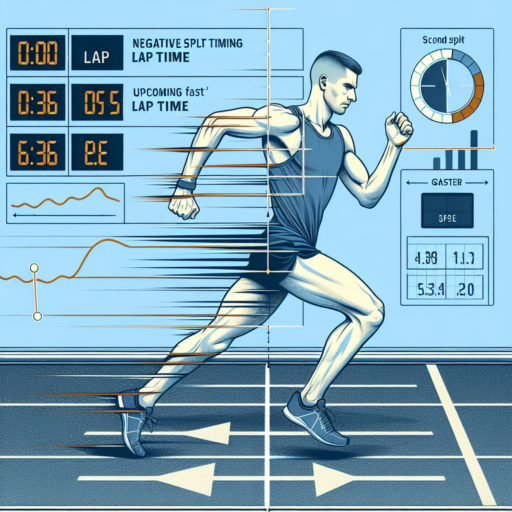What is a negative split time?
In the realm of both amateur and professional racing, the strategy behind achieving your best time is often a subject of intense scrutiny and debate. Among these strategies, the concept of a negative split time plays a pivotal role for athletes striving for peak performance. Essentially, a negative split refers to the technique of completing the second half of a race faster than the first half. This method contrasts with running at a steady pace throughout the race or starting fast and slowing down towards the end, known as a positive split.
The execution of a negative split time requires not just physical readiness but also a high degree of mental discipline and pacing awareness. Athletes and coaches meticulously plan and practice this approach, aiming to conserve energy in the initial stages of the race, only to unleash their full potential in the latter stages. The magic of a negative split lies in its ability to minimize fatigue, maintain a consistent speed, and potentially lead to personal best performances. It’s a testament to the power of strategic pacing over sheer speed from the starting gun.
Adopting a negative split strategy has been seen in various types of races, from marathons to shorter distance track events, and even in swimming and cycling competitions. It’s a universal concept that transcends specific sports disciplines, highlighting its importance in the broader context of racing strategies. Properly executing a negative split can make the difference between simply finishing a race and achieving a new personal record. Consequently, it’s a strategy often discussed in coaching sessions, athlete self-assessments, and sports strategy analysis.
How do you pace negative splits?
Pacing negative splits, an effective strategy especially prevalent in distance running and endurance sports, demands discipline and an understanding of one’s capabilities. The concept involves completing the second half of your race or activity faster than the first half. But how is this methodically achieved? First and foremost, it’s about knowing your current performance level and setting realistic targets based on that understanding.
Begin with a comprehensive warm-up to prepare your body for the task ahead. This step is crucial for gradually elevating your heart rate and loosening your muscles, thus making the transition into a faster pace more fluid and less shocking to the system. Once the race starts, consciously hold back and maintain a pace that feels comfortably under your maximum effort. It’s challenging, as the initial adrenaline can tempt you to go faster, but restraint here is key. Use a running watch or app to monitor your pace, ensuring you’re not speeding up too early.
Dividing the race into smaller segments can mentally and physically aid in handling the challenge of pacing for negative splits. Consider the race as a series of two or three segments where each part is run slightly faster than the last. For the final push, tap into your reserved energy to increase your speed, ideally in the last third or quarter of the race. This gradual acceleration not only conserves energy but also prepares you for a strong finish, leveraging the power of negative splits effectively.
What is a negative split in 800m?
In the world of track and field, the term negative split describes a strategic approach where an athlete completes the second half of a race faster than the first half. This concept, particularly relevant in the 800m event, is often employed by middle-distance runners aiming to conserve energy during the initial stages and unleash their peak performance in the latter stages of the race. Understanding and implementing a negative split requires meticulous pacing and a strong psychological game, as it relies heavily on patience, discipline, and the ability to accurately judge one’s own pace and endurance capabilities.
The adoption of a negative split strategy in the 800m is not merely a test of physical endurance but also a tactical challenge. Runners must navigate the balance between starting too fast, which could lead to premature fatigue, and being too conservative at the race’s outset, risking insufficient time to make up ground in the second lap. The beauty of executing a negative split lies in the runner’s ability to gradually build their speed, overtaking competitors who may have expended too much energy too soon. This strategy requires a deep understanding of one’s own body and a keen sense of competitors’ pacing.
Implementing this approach effectively in the 800m demands rigorous training focused on pace judgment and the development of a robust aerobic foundation. Athletes often practice varying their speeds in training, learning to conserve energy and when to kick into a higher gear. This not only enhances their physical capability but also hones their mental fortitude, preparing them to remain calm and focused under the race’s pressure. A negative split is a powerful tool in a racer’s arsenal, potentially leading to personal bests when executed correctly.
No se han encontrado productos.
What is split timing?
Split timing is a concept commonly encountered within the world of sports, particularly in track and field, swimming, and various forms of racing. It refers to the method of breaking down the entire duration of a race or an activity into smaller, manageable segments or splits, in order to analyze the performance over specific distances or intervals. Understanding split timing is essential for athletes and coaches as it provides critical insights into pace consistency, endurance, and strategic race planning.
In essence, split timing allows for a detailed assessment of an athlete’s performance throughout the course of a race. For instance, in a 1500m track event, split times may be recorded at each 300m interval. This granularity enables athletes and coaches to pinpoint exactly where in the race an athlete may be excelling or facing challenges. It’s not just about the final time; it’s about the journey and how the time was achieved over each section of the race.
Applications of Split Timing
- Performance Analysis: Coaches and athletes use split times to analyze pacing and develop strategies for future races.
- Training Adjustments: Identifying parts of the race where an athlete can improve helps in tailoring training sessions to address specific needs.
- Comparative Assessment: Athletes can compare their split times against competitors or against their own previous performances, providing motivation and targets for improvement.
Overall, split timing is more than just a set of numbers; it represents a deeper look into the dynamics of an athlete’s performance. By dissecting races into smaller segments, it allows for a nuanced understanding and optimization of an athlete’s strategy and capabilities throughout the duration of a competition.




